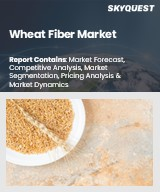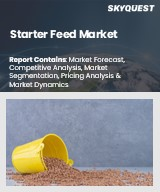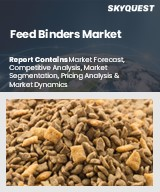
|
시장보고서
상품코드
1636690
배양 밀 시장 예측(-2030년) : 제품 유형별, 밀 유형별, 유통 채널별, 용도별, 최종 사용자별, 지역별 세계 분석Cultured Wheat Market Forecasts to 2030 - Global Analysis By Product Type (Flour, Protein, Starch, Oil, Fiber and Other Product Types), Wheat Type, Distribution Channel, Application, End User and By Geography |
||||||
Stratistics MRC에 따르면 세계 배양 밀 시장은 2024년에 7억 410만 달러를 차지했습니다. 예측 기간 동안 CAGR 7.1%로 성장하며 2030년에는 10억 6,260만 달러에 이를 것으로 예측됩니다.
배양 밀이란 조직 배양, 유전자 재조합, 선택 육종 등의 고도의 농업 기술을 이용하여 재배되어 그 특성을 향상시키는 밀입니다. 이 방법은 밀의 수율과 영양 함량을 증가시키면서 질병, 해충 및 환경 스트레스에 대한 내성을 향상시키는 것을 목표로합니다. 배양 밀은 다양한 기후에 대한 적응성 향상과 생산성 향상 등 특정 농업 요구에 맞게 설계되는 경우가 많으며, 미래의 식량 생산에 있어 지속가능하고 효율적인 작물을 보장합니다.
깨끗한 라벨과 천연 제품에 대한 수요 증가
시장에서 깨끗한 라벨 및 자연 제품에 대한 수요 증가는 투명성, 건강 지향 선택 및 지속가능성에 대한 소비자의 선호도 증가로 이어집니다. 소비자는 인공적인 첨가물, 보존제, 화학물질을 포함하지 않는 제품을 적극적으로 요구하고 있으며, 제조업체가 천연 소재나 보다 간단한 처방을 채용하도록 추진하고 있습니다. 이 변화는 각 브랜드가 소비자의 진화하는 가치관에 맞는 고품질의 건강한 제품을 제공하는 데 주력하면서 배양 밀 업계의 혁신을 촉진합니다.
제한된 원료의 가용성
시장에서 원재료의 이용가능성이 제한되어 있는 것은 생산비용의 상승과 공급망의 혼란으로 이어지는 큰 과제가 되고 있습니다. 주요 원재료 부족은 제조업체가 증가하는 수요에 대응하는 능력을 제한하고 제품 가용성에 영향을 미치고 가격을 상승시킬 수 있습니다. 이 부족은 또한 생산자가 고품질 원재료를 조달하는 데 어려움을 겪기 때문에 기술 혁신을 지연시키고 궁극적으로 시장 내 기업의 성장 가능성과 수익성을 제한할 수 있습니다.
글루텐이 없는 대체 식품에 대한 관심 증가
글루텐이 없는 대체 식품에 대한 관심 증가는 시장에 큰 영향을 미칩니다. 건강상의 이유와 식생활의 취향으로부터 글루텐 프리의 식생활을 채용하는 소비자가 증가하고 있어, 글루텐 프리의 밀 기반의 제품에 대한 수요가 높아지고 있습니다. 신흥국 시장은 이 시장 변화에 대응하기 위해 혁신적인 밀 대체품과 글루텐 프리 제제를 개발하고 있습니다. 이 트렌드는 글루텐이 없는 배양 밀 제품의 확대를 촉진하고 맛과 식감을 유지하면서 더 건강한 선택을 제공합니다.
높은 생산 비용
시장에서 높은 제조 비용은 제조업체의 수익성과 가격 전략에 부정적인 영향을 미칠 수 있습니다. 고가의 원재료, 고급 가공 기술, 노동 집약적인 제법이 비용 상승의 원인이 되고 있습니다. 그 결과, 경쟁력 있는 가격 설정이 과제가 되어, 소비자 시장 진입이 제한될 가능성이 있습니다. 게다가, 고비용은 기술 혁신과 사업 확대를 방해하여 변화하는 시장 수요와 소비자 선호에 대응하는 기업의 능력을 저하시킬 수 있습니다.
COVID-19의 영향 :
COVID-19의 유행은 시장에 큰 영향을 주었으며 공급망 혼란, 원료 부족, 생산 지연을 유발했습니다. 락다운과 여행 제한이 제조 능력에 영향을 미치는 반면 소비자의 구매 행동은 변화하고 건강 지향과 지속 가능한 제품에 대한 주목이 높아졌습니다. 이러한 과제에도 불구하고 팬데믹은 식물 유래나 글루텐 프리 대체품에 대한 수요를 가속화시켜 소비자가 보다 건강한 선택을 요구하는 가운데 배양 밀 섹터의 기술 혁신과 더욱 성장을 가속했습니다.
예측 기간 동안 단백질 부문이 최대가 될 전망
단백질 분야는 예측 기간 동안 최대 시장 점유율을 차지할 것으로 예상됩니다. 발효와 생명공학을 사용하여 생산되는 배양 밀은 전통적인 밀 재배를 위한 지속가능하고 효율적인 대안을 제공합니다. 다양한 식품에 고품질의 영양가가 높은 단백질원을 제공하여 채식주의자와 건강 지향 소비자층 증가에 대응합니다. 식품기술의 혁신과 지속가능성에 대한 관심이 높아짐에 따라 시장 확대가 더욱 강화되고 있습니다.
바이오 비료 분야는 예측기간 중 가장 높은 CAGR이 예상됩니다.
바이오 비료 분야는 지속가능성과 작물 수율을 향상시키기 위해 예측 기간 동안 가장 높은 CAGR이 예상됩니다. 유익한 미생물의 성장을 가속함으로써 바이오 비료는 토양의 건전성을 향상시키고 화학 비료의 필요성을 줄입니다. 배양 밀의 생산에서는 발효 과정을 최적화하고, 밀의 강력한 성장을 가속하며, 보다 고품질의 단백질 생산에 기여합니다. 환경 친화적 인 농법과 유기 제품에 대한 수요 증가가 바이오 비료의 채택을 뒷받침하고 있습니다.
최대 점유율을 차지하는 지역 :
북미는 환경 친화적이고 고단백질 선택을 선호하는 소비자 증가로 예측 기간 동안 최대 시장 점유율을 차지할 것으로 예상됩니다. 식품기술의 혁신에 강한 주목을 받고 있는 가운데, 기업은 기존의 밀 재배를 대체할 수 있는 가능한 옵션으로 배양 밀을 모색하고 있습니다. 게다가 유리한 규제, R&D 투자, 농업이 환경에 미치는 영향에 대한 인식이 높아지면서 이 지역 시장 성장을 더욱 강화하고 있습니다.
CAGR이 가장 높은 지역 :
예측 기간 동안 아시아태평양이 가장 높은 성장률을 나타낼 것으로 예상됩니다. 세포 배양 기술의 개발과 식품 기술 분야에 대한 투자의 확대가 함께, 배양 밀의 대규모 생산이 점점 가능해지고 있습니다. 이 기술은 이 지역에서 시장 확대의 원동력으로 매우 중요합니다. 또한 환경문제, 특히 농업의 이산화탄소 배출에 대한 우려가 높아짐에 따라 실험실에서 재배된 지속가능한 단백질에 대한 수요가 증가하고 있습니다.
무료 맞춤설정 제공 :
이 보고서를 구독하는 고객은 다음 무료 맞춤설정 옵션 중 하나를 사용할 수 있습니다.
- 기업 프로파일
- 추가 시장 기업의 종합적 프로파일링(3개사까지)
- 주요 기업의 SWOT 분석(3개사까지)
- 지역 세분화
- 고객의 관심에 응한 주요국 시장 추계·예측·CAGR(참고 : 타당성 확인에 따름)
- 경쟁 벤치마킹
- 제품 포트폴리오, 지리적 존재, 전략적 제휴에 기반한 주요 기업 벤치마킹
목차
제1장 주요 요약
제2장 서문
- 개요
- 이해관계자
- 조사 범위
- 조사 방법
- 데이터 마이닝
- 데이터 분석
- 데이터 검증
- 조사 접근
- 조사 정보원
- 1차 조사 정보원
- 2차 조사 정보원
- 전제조건
제3장 시장 동향 분석
- 성장 촉진요인
- 성장 억제요인
- 기회
- 위협
- 제품분석
- 용도 분석
- 최종 사용자 분석
- 신흥 시장
- COVID-19의 영향
제4장 Porter's Five Forces 분석
- 공급기업의 협상력
- 구매자의 협상력
- 대체품의 위협
- 신규 진입업자의 위협
- 경쟁 기업간 경쟁 관계
제5장 세계의 배양 밀 시장 : 제품 유형별
- 밀가루
- 단백질
- 전분
- 기름
- 섬유질
- 기타 제품 유형
제6장 세계의 배양 밀 시장 : 밀 유형별
- 하드밀
- 소프트 밀
- 듀럼밀
제7장 세계의 배양 밀 시장 : 유통 채널별
- 직접 판매
- 소매
- 온라인 판매
제8장 세계의 배양 밀 시장 : 용도별
- 제빵 식품
- 바이오 연료
- 생분해성 플라스틱
- 바이오 비료
- 항산화 물질
- 생체 재료
- 기타 용도
제9장 세계 배양 밀 시장 : 최종 사용자별
- 식품 및 음료
- 동물사료
- 영양보조식품
- 화장품 및 퍼스널케어
- 농업
- 기타 최종 사용자
제10장 세계의 배양 밀 시장 : 지역별
- 북미
- 미국
- 캐나다
- 멕시코
- 유럽
- 독일
- 영국
- 이탈리아
- 프랑스
- 스페인
- 기타 유럽
- 아시아태평양
- 일본
- 중국
- 인도
- 호주
- 뉴질랜드
- 한국
- 기타 아시아태평양
- 남미
- 아르헨티나
- 브라질
- 칠레
- 기타 남미
- 중동 및 아프리카
- 사우디아라비아
- 아랍에미리트(UAE)
- 카타르
- 남아프리카
- 기타 중동 및 아프리카
제11장 주요 발전
- 계약/파트너십/협업/합작투자(JV)
- 인수와 합병
- 신제품 발매
- 사업 확대
- 기타 주요 전략
제12장 기업 프로파일링
- Cargill Inc.
- ADM
- BASF SE
- DuPont de Nemours, Inc.
- Ingredion Incorporated
- Kerry Group
- Tate & Lyle PLC
- Naturex SA
- Royal DSM
- Symrise AG
- Plastipak Packaging
- ConAgra Brands
- Sealed Air Corporation
- MGP Ingredients
- AGP Group
According to Stratistics MRC, the Global Cultured Wheat Market is accounted for $704.1 million in 2024 and is expected to reach $1,062.6 million by 2030 growing at a CAGR of 7.1% during the forecast period. Cultured wheat is wheat that is cultivated using advanced agricultural techniques, such as tissue culture, genetic modification, or selective breeding, to enhance its properties. These methods aim to improve the wheat's resistance to diseases, pests, and environmental stresses while boosting its yield and nutritional content. Cultured wheat is often designed for specific agricultural needs, such as better adaptability to diverse climates or higher productivity, ensuring a more sustainable and efficient crop for future food production.
Market Dynamics:
Driver:
Growing demand for clean label and natural products
The growing demand for clean label and natural products in the market is driven by increasing consumer preferences for transparency, health-conscious choices, and sustainability. Consumers are actively seeking products free from artificial additives, preservatives, and chemicals, pushing manufacturers to adopt natural ingredients and simpler formulations. This shift is fostering innovation in the cultured wheat industry, as brands focus on delivering high-quality, wholesome products that align with evolving consumer values.
Restraint:
Limited availability of raw materials
The limited availability of raw materials in the market poses a significant challenge, leading to higher production costs and supply chain disruptions. Scarcity of key ingredients can restrict manufacturers' ability to meet growing demand, impacting product availability and potentially increasing prices. This shortage can also slow innovation, as producers struggle to source quality raw materials, ultimately limiting the growth potential and profitability of companies within the market.
Opportunity:
Increasing interest in gluten-free alternatives
The rising interest in gluten-free alternatives is significantly impacting the market. With more consumers adopting gluten-free diets due to health reasons or dietary preferences, there is a growing demand for gluten-free wheat-based products. Manufacturers are responding by developing innovative wheat substitutes and gluten-free formulations to cater to this market shift. This trend is driving the expansion of gluten-free cultured wheat products, offering healthier options while maintaining taste and texture.
Threat:
High Production Costs
High production costs in the market can negatively impact profitability and pricing strategies for manufacturers. Expensive raw materials, advanced processing technologies, and labor-intensive methods contribute to these elevated costs. As a result, companies may face challenges in offering competitive pricing, potentially limiting market accessibility for consumers. Additionally, high costs could hinder innovation and expansion, reducing the ability of businesses to respond to changing market demands and consumer preferences.
Covid-19 Impact:
The COVID-19 pandemic had a significant impact on the market, causing disruptions in supply chains, raw material shortages, and production delays. Lockdowns and travel restrictions affected manufacturing capacities, while consumer purchasing behavior shifted, with an increased focus on health-conscious and sustainable products. Despite these challenges, the pandemic accelerated demand for plant-based and gluten-free alternatives, driving innovation and further growth in the cultured wheat sector as consumers sought healthier options.
The protein segment is expected to be the largest during the forecast period
The protein segment is anticipated to account for the largest market share during the projection period. Cultured wheat, produced using fermentation and biotechnology, offers a sustainable and efficient alternative to traditional wheat farming. It provides a high-quality, nutrient-rich protein source for various food products, catering to the growing vegan and health-conscious consumer base. Innovations in food technology and the increasing focus on sustainability further fuel market expansion.
The biofertilizers segment is expected to have the highest CAGR during the forecast period
The biofertilizers segment is expected to have the highest CAGR during the extrapolated period enhancing sustainability and crop yields. By promoting the growth of beneficial microorganisms, biofertilizers improve soil health and reduce the need for chemical fertilizers. In cultured wheat production, they help optimize the fermentation process and promote robust wheat growth, contributing to higher-quality protein output. The growing demand for eco-friendly farming practices and organic products drives the adoption of biofertilizers.
Region with largest share:
North America region is anticipated to account for the largest market share during the forecast period driven by consumers' growing preference for environmentally friendly, high-protein options. With a strong focus on innovation in food technology, companies are exploring cultured wheat as a viable alternative to traditional wheat farming. Additionally, favorable regulations, investment in research and development, and a growing awareness of the environmental impact of agriculture further support the region's market growth.
Region with highest CAGR:
Asia Pacific is expected to register the highest growth rate over the forecast period. The development of cell-culturing techniques, combined with growing investments in the food-tech sector, is making it increasingly feasible to produce cultured wheat at scale. This technology is crucial for driving the market's expansion in the region. Additionally, as environmental concerns increase, especially regarding agricultural practices' carbon footprint, the demand for lab-grown and sustainable proteins is on the rise.
Key players in the market
Some of the key players in Cultured Wheat market include Cargill Inc., ADM , BASF SE, DuPont de Nemours, Inc., Ingredion Incorporated, Kerry Group, Tate & Lyle PLC, Naturex S.A., Royal DSM, Symrise AG, Plastipak Packaging, ConAgra Brands, Sealed Air Corporation, MGP Ingredients and AGP Group.
Key Developments:
In February 2024, Cargill and food tech leader ENOUGH has expanded their partnership to further innovate nutritious and sustainable alternative meat and dairy solutions consumers crave. Cargill is investing in ENOUGH's most recent (Series C) growth funding campaign and has signed a commercial agreement to use and market its fermented protein.
In February 2024, ADM announced a trial programme with Voltloader, an innovative logistics and transportation company focused on the electrification of HGVs, to leverage Voltloader's cutting-edge electric bulk fleet vehicles to transport wheat from farm fields to ADM processing locations.
Product Types Covered:
- Flour
- Protein
- Starch
- Oil
- Fiber
- Other Product Types
Wheat Types Covered:
- Hard Wheat
- Soft Wheat
- Durum Wheat
Distribution Channels Covered:
- Direct Sales
- Retail
- Online Sales
Applications Covered:
- Baked Goods
- Biofuels
- Biodegradable Plastics
- Biofertilizers
- Antioxidants
- Biomaterials
- Other Applications
End Users Covered:
- Food & Beverages
- Animal Feed
- Nutraceuticals
- Cosmetics and Personal Care
- Agriculture
- Other End Users
Regions Covered:
- North America
- US
- Canada
- Mexico
- Europe
- Germany
- UK
- Italy
- France
- Spain
- Rest of Europe
- Asia Pacific
- Japan
- China
- India
- Australia
- New Zealand
- South Korea
- Rest of Asia Pacific
- South America
- Argentina
- Brazil
- Chile
- Rest of South America
- Middle East & Africa
- Saudi Arabia
- UAE
- Qatar
- South Africa
- Rest of Middle East & Africa
What our report offers:
- Market share assessments for the regional and country-level segments
- Strategic recommendations for the new entrants
- Covers Market data for the years 2022, 2023, 2024, 2026, and 2030
- Market Trends (Drivers, Constraints, Opportunities, Threats, Challenges, Investment Opportunities, and recommendations)
- Strategic recommendations in key business segments based on the market estimations
- Competitive landscaping mapping the key common trends
- Company profiling with detailed strategies, financials, and recent developments
- Supply chain trends mapping the latest technological advancements
Free Customization Offerings:
All the customers of this report will be entitled to receive one of the following free customization options:
- Company Profiling
- Comprehensive profiling of additional market players (up to 3)
- SWOT Analysis of key players (up to 3)
- Regional Segmentation
- Market estimations, Forecasts and CAGR of any prominent country as per the client's interest (Note: Depends on feasibility check)
- Competitive Benchmarking
- Benchmarking of key players based on product portfolio, geographical presence, and strategic alliances
Table of Contents
1 Executive Summary
2 Preface
- 2.1 Abstract
- 2.2 Stake Holders
- 2.3 Research Scope
- 2.4 Research Methodology
- 2.4.1 Data Mining
- 2.4.2 Data Analysis
- 2.4.3 Data Validation
- 2.4.4 Research Approach
- 2.5 Research Sources
- 2.5.1 Primary Research Sources
- 2.5.2 Secondary Research Sources
- 2.5.3 Assumptions
3 Market Trend Analysis
- 3.1 Introduction
- 3.2 Drivers
- 3.3 Restraints
- 3.4 Opportunities
- 3.5 Threats
- 3.6 Product Analysis
- 3.7 Application Analysis
- 3.8 End User Analysis
- 3.9 Emerging Markets
- 3.10 Impact of Covid-19
4 Porters Five Force Analysis
- 4.1 Bargaining power of suppliers
- 4.2 Bargaining power of buyers
- 4.3 Threat of substitutes
- 4.4 Threat of new entrants
- 4.5 Competitive rivalry
5 Global Cultured Wheat Market, By Product Type
- 5.1 Introduction
- 5.2 Flour
- 5.3 Protein
- 5.4 Starch
- 5.5 Oil
- 5.6 Fiber
- 5.7 Other Product Types
6 Global Cultured Wheat Market, By Wheat Type
- 6.1 Introduction
- 6.2 Hard Wheat
- 6.3 Soft Wheat
- 6.4 Durum Wheat
7 Global Cultured Wheat Market, By Distribution Channel
- 7.1 Introduction
- 7.2 Direct Sales
- 7.3 Retail
- 7.4 Online Sales
8 Global Cultured Wheat Market, By Application
- 8.1 Introduction
- 8.2 Baked Goods
- 8.3 Biofuels
- 8.4 Biodegradable Plastics
- 8.5 Biofertilizers
- 8.6 Antioxidants
- 8.7 Biomaterials
- 8.8 Other Applications
9 Global Cultured Wheat Market, By End User
- 9.1 Introduction
- 9.2 Food & Beverages
- 9.3 Animal Feed
- 9.4 Nutraceuticals
- 9.5 Cosmetics and Personal Care
- 9.6 Agriculture
- 9.7 Other End Users
10 Global Cultured Wheat Market, By Geography
- 10.1 Introduction
- 10.2 North America
- 10.2.1 US
- 10.2.2 Canada
- 10.2.3 Mexico
- 10.3 Europe
- 10.3.1 Germany
- 10.3.2 UK
- 10.3.3 Italy
- 10.3.4 France
- 10.3.5 Spain
- 10.3.6 Rest of Europe
- 10.4 Asia Pacific
- 10.4.1 Japan
- 10.4.2 China
- 10.4.3 India
- 10.4.4 Australia
- 10.4.5 New Zealand
- 10.4.6 South Korea
- 10.4.7 Rest of Asia Pacific
- 10.5 South America
- 10.5.1 Argentina
- 10.5.2 Brazil
- 10.5.3 Chile
- 10.5.4 Rest of South America
- 10.6 Middle East & Africa
- 10.6.1 Saudi Arabia
- 10.6.2 UAE
- 10.6.3 Qatar
- 10.6.4 South Africa
- 10.6.5 Rest of Middle East & Africa
11 Key Developments
- 11.1 Agreements, Partnerships, Collaborations and Joint Ventures
- 11.2 Acquisitions & Mergers
- 11.3 New Product Launch
- 11.4 Expansions
- 11.5 Other Key Strategies
12 Company Profiling
- 12.1 Cargill Inc.
- 12.2 ADM
- 12.3 BASF SE
- 12.4 DuPont de Nemours, Inc.
- 12.5 Ingredion Incorporated
- 12.6 Kerry Group
- 12.7 Tate & Lyle PLC
- 12.8 Naturex S.A.
- 12.9 Royal DSM
- 12.10 Symrise AG
- 12.11 Plastipak Packaging
- 12.12 ConAgra Brands
- 12.13 Sealed Air Corporation
- 12.14 MGP Ingredients
- 12.15 AGP Group



















